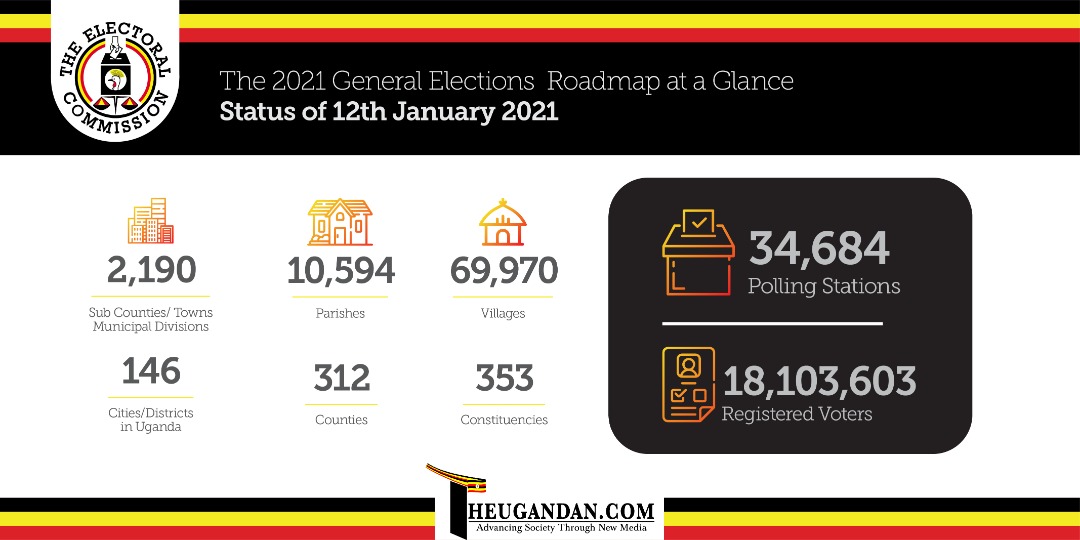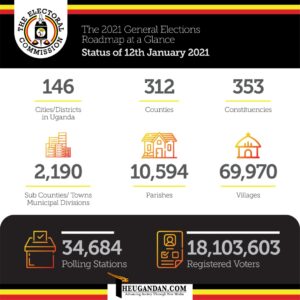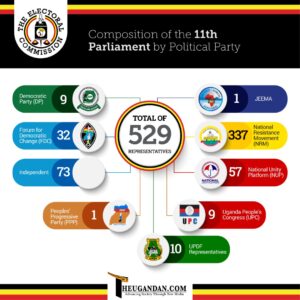Works, energy and education sectors have taken a lion’s share according to 2017/18 budget
Kasaija presented the sh29trillion budget to MPs, government bodies heads and dignitaries at Serena Conference hall in Kampala which was attended by President Yoweri Museveni.
Your Excellency the President,
Your Excellency the Vice President,
Right Honourable Speaker of Parliament,
His Lordship the Chief Justice,
His Lordship the Deputy Chief Justice,
Right Hon. Deputy Speaker of Parliament,
Right Hon. Prime Minister,
Right Hon Deputy Prime Ministers,
Right Hon. Leader of the Opposition,
Honourable Ministers,
Honourable Members of Parliament,
Your Excellences, Ambassadors and Heads of Diplomatic Missions,
Ladies and Gentlemen,
Kasaija: Hon. Speaker, in accordance with Article 155(1) of the Constitution of the Republic of Uganda, I presented, on behalf of His Excellency, the President, the Budget for Financial Year 2017/18 to Parliament in April 2017. In line with the Public Finance Management Act 2015 as amended, the Budget was approved by Parliament on 31st May 2017. I salute Parliament for this approval. I am now honoured to present a statement outlining the highlights of the Approved Budget.
Madam Speaker, in my presentation today I will cover the following:-
- i) Report on the state of the economy, and spell out the immediate and medium term strategies that will stimulate our the economy and propel Uganda into Middle Income Status;
- ii) Update Parliament on the performance of key selected sectors in financial year 2016/17 Budget, and the priorities for the next financial year; and
iii) Highlight the financial year 2017/18 revenue and expenditure framework and measures to enhance domestic revenue mobilization.
Kasaija: Madam Speaker, Uganda’s development achievements provide renewed confidence in the NRM Government’s strategy to transform Uganda from a peasant to a modern and prosperous country, as stipulated in our Vision 2040.
In this regard, according to the latest statistics, many Ugandans are now living longer and better lives. Let me give examples
- i) Life expectancy today is 63 years, up from 48 years in 2002.
- ii) Literacy rates for adults now stand at 74% rising from 68% in 2002.
iii) 79% of the population now accesses safe water compared to 59% over the same period.
- iv) Immunization of children against measles is now 82% up from 62% fifteen years ago.
- v) Per capita incomes in real terms have more than tripled to USD 773 in 2016 up from USD 250 in 2002. This is despite an increase in population from 26 million to 36.9 million people.
Kasaija: Madam Speaker, despite progress on these socio-economic outcomes, a lot more needs to be done. Per capita income has been growing at only 2% annually compared with population growth of 3% per annum. This needs to be reversed. There is growing unemployment, especially among the youth. We are increasingly faced with the prolonged droughts as a result of partly environmental damage arising from the destruction of wetlands and deforestation. Land fragmentation is another challenge. Agriculture, the mainstay of the vast majority of Ugandans, is now at risk because of excessive reliance on rain-fed farming.
These challenges require immediate redress.
- Madam Speaker, as such Government plans to turnaround the economy by enhancing agricultural production and productivity, as well as increasing the pace of industrialization. For example, the vagaries of climate change will be tackled by, among others, fast-tracking irrigation. As regards industrialization Government will, first and foremost, vigorously promote agro-processing and mineral beneficiation. Through this double pronged approach we shall be addressing the unemployment.
- It is for these reasons, therefore, the theme for the Financial Year 2017/18 Budget is ‘Industrialization for Job Creation and Shared Prosperity’.
THE STATE OF THE ECONOMY
Kasaija:
Madam Speaker, before I report on sector performance and spell out the priorities for next financial year, let me give an account of the state of the economy today. Which are the factors that have affected Uganda’s economic and social progress, and may impact our future prospects?
Global Factors
Global factors that have negatively impacted on our economy include the following:-
- i) Slow economic recovery in Europe. This has translated into lower demand for our export commodities.
- ii) Economic recovery in the USA. This has led to a reduction in capital flows to Africa, as investors prefer to invest in US markets.
iii) Rise in interest rates globally. This has resulted in high cost of capital and borrowing.
Regional and Domestic Factors
- Madam Speaker, regional and domestic developments that have affected the state of the economy include the following:-
- i) Civil conflicts in parts of the East African region. This has disrupted export markets for our goods and services. Additionally, these conflicts have led to influx of refugees into Uganda, putting pressure on our social amenities.
- ii) Effects of climate change and environmental degradation. These have undermined food security and economic growth.
iii) High interest rates and non-performing loans. This has constrained private sector growth;
- iv) Undue Delays and inefficiency in execution of Government programmes and projects. These have dampened anticipated positive impact on the economy.; and
- v) Corruption. This has held back projects and programmes in some sectors. This disease has turned into Cancer, which has hampered service delivery.
Minister Kasaija: Madam Speaker, despite these challenges, Uganda’s economy is not in recession but growing moderately. The size of the economy this financial year is projected to rise to Shs 90.5 trillion, equivalent to USD 25.7 billion. This represents a real annual economic growth rate of 3.9%. Although this is lower than the target growth of 5.5%, Uganda’s performance is higher than the average Sub-Saharan Africa growth rate this year, which is estimated to be only 1.4%.
Growth in agricultural output slowed to 1.3% this year compared to 2.8% in the previous year, the main reason being the unusually prolonged droughts. Industrial sector growth also dropped to 3.4% this year as against 4.7% last year.
This is because of contraction in mining and quarrying activities. The Construction sector also slowed down. Growth in Services also slowed to 5.1% compared to 5.9% last year as a result of marginal growth in trade and transportation, and contraction in financial services. But on a positive note, aggregate demand, while subdued, has grown at 2.7% this year, compared to 1.0% last year.
Minister Kasaija: Madam Speaker, while the financial sector remains well-capitalized, a sharp rise in interest rates in 2013 led to increased non-performing loans which peaked at 10.5% of total loans in December 2016, but have gladly reduced to 6.3% as at the end of March 2017.
Public Debt
Madam Speaker, Uganda’s external and domestic Public debt amounted to USD 8.7 billion as of 31st December 2016. In nominal terms this is equivalent to 33.8% of our GDP. However, when future debt payment obligations are discounted to today’s value, our Public Debt to GDP ratio stands at 27%. This is much lower than the threshold of 50% beyond which public debt becomes unsustainable. Uganda’s public debt therefore, is sustainable over the medium to long term.
Reserves, Exchange Rate and Inflation
Madam Speaker, International reserves at end December 2016 stood at US$ 3 billion, equivalent to 4.2 months of imports of goods and services. This is close to the target of 4.5 months of import cover to be achieved in 2021, as agreed in the EAC Monetary Union protocol.
Madam Speaker, the exchange rate has remained broadly stable for much of the financial year, averaging Shs 3,532 to the US Dollar.
Madam Speaker, Inflation remained within single digit at 6.8% despite pressure from food crop prices.
THE ECONOMIC OUTLOOK AND GROWTH STRATEGY
Future Economic OutlookMinister Matia Kasaija: Madam Speaker, Uganda aims to graduate to middle income status by 2020. Average incomes, or GDP per capita will therefore need to rise to USD 1,039. Given a population estimate of about 41 million people by 2020, the size of the economy will need to grow by an additional USD 17 billion for us to attain that target.
In order to attain this target, the following must be done:-
- i) Immediately re-organize the Agriculture sector to increase production and productivity;
- ii) Address the impact of climate change to eliminate reliance on rain fed agriculture and protect and restore the environment;
iii) Harness the huge tourism potential that we have;
- iv) Aggressively industrialize the economy anchored on agro-processing and the extraction of Minerals, Oil and Gas;
- v) Reform the financial sector to provide long term capital and reduce interest rates;
- vi) Speed up execution of Government projects and programmes; and
vii) Ruthlessly deal with corruption of some elements in the public service that frustrate investors.
- Madam Speaker, as result of these actions, the economy is expected to rebound to annual growth rates of 7% in the medium term, as a minimum.
- Madam Speaker, in summary our economic growth strategy therefore rests on four pillars. These are:
- i) Increasing production and productivity in the key primary growth sectors of Agriculture, Tourism and Minerals, Oil and Gas;
- ii) Industrialization through Value Addition;
iii) Enhanced Private Sector Development; and
- iv) Increased Public Sector Efficiency.
Production and Productivity in Key Primary Growth Sectors
Minister Kasaija: Madam Speaker, the primary sectors where Uganda has competitive advantage are Agriculture, Tourism, Minerals, Oil and Gas.
Key Primary Sector Challenges
- The Agriculture sector is key in providing food security and export earnings, in addition to creating gainful job opportunities for Ugandan youth and women. The challenges which Government must address in Agriculture include the following:
- i) Climate change arising partly from the destruction of wetlands and deforestation. The consequence of this is prolonged droughts, and in some cases floods;
- ii) Low survival rates of distributed seedlings currently estimated at about 40%. This is the result of poor quality inputs mismatch between input distribution and planting seasons, weak extension services, and excessive dependence on rain-fed agriculture;
iii) Inadequate post-harvest handling infrastructure that accounts for over 30% loss of production;
- iv) Inadequate compliance with and enforcement of standards right from farms to processors;
- v) High cost of financing for agriculture enterprises with some agricultural projects being charged interest rates as high as 30% per annum; and
- vi) Lack of coordination among institutions in the Agricultural Sector.
Kasaija: Madam Speaker, Uganda has a huge tourism potential, but is constrained by poor infrastructure to access tourism sites, inadequate skills in the hospitality industry and low visibility to attract national and international tourists. In addition, tourist products are under developed and protected areas suffer human encroachment with wildlife endangered by illegal hunting and trade.
In the Minerals sub-sector the current problem is a fragmented legal framework. This partly leads to low investment. As far as Oil and Gas are concerned, key projects such as the Oil Refinery and the East Africa Crude Oil Pipeline need to be fast tracked.
Strategic Interventions
Madam Speaker, in Agriculture, measures to address the challenges I have mentioned will include reforestation, restoration and prevention of wetland destruction and enhancing irrigation. In addition, reorganizing the procurement and distribution of planting materials for better quality and timely delivery is a must. In Tourism, measures include increased promotion and marketing of tourist products and building skills in the hospitality industry. To promote commercial production In the Minerals sub-sector, the legal framework will be reviewed to improve governance. As for the Oil Refinery and Crude Oil Pipeline projects, this will necessitate fast-tracking to produce the first oil by 2020. I will elaborate details of these priority actions when I delve into sector priorities.
Industrialization through Value Addition
Minister Kasaija: Madam Speaker, Uganda’s industrialization will be anchored on agriculture, agro-processing and value addition. Linking agriculture to industry is the strategy in which the economy will be transformed to deliver inclusive growth and development. The strategic objectives to achieve the Industrialization strategy are the following:
- i) Promoting processing of agricultural raw materials;
- ii) Building linkages between agro-industries and farms;
iii) Adapting farmers to meet industrial and market needs by increasing production of quality raw materials in sufficient quantities; and
- iv) Developing Agro-industrial Clusters in agro-ecological zones,
Minister Kasaija: Madam Speaker, these Industrialization strategic objectives will be met through the following actions:-
- i) Agricultural zoning, as already defined by the Ministry of Agriculture
- ii) Support to innovation by building a critical mass of highly skilled ICT, science, technology and engineering professionals to drive industrialization.
I have therefore provided Shs 43 billion to establish an Innovation Fund, of which Shs 13 billion will finance talented youth in the ICT Sector;
iii) Provision of fully-serviced, demarcated industrial and business parks.
This means provision of adequate electricity, water, telecommunications starting with Luzira, Jinja and Namanve/Bukasa; and
- iv) Skills Training, Business Incubation, Work Spaces provision and financing of SME Product Start-up Kits.
This will promote value addition by Small and Medium-scale Enterprises (SMEs).
Private Sector Development
Minister Matia Kasaija: Madam Speaker, the private sector, as we all know, plays a key role in production, trade, export promotion and employment creation. Concerted efforts by the Heads of State of the Northern Corridor has eliminated non-tariff barriers along the Corridor consequently reducing the costs of doing business and improving trade. For example:- Port transit and border clearance times have improved significantly. Clearance of goods at Mombasa Port has been reduced from 13 to 5 days. The transit time for goods from Kenya has reduced from 4 to 2 days. It now takes an average of 4 hours to clear through Malaba, compared to 24 hours previously.
Key Private Sector Challenges
Minister Matia Kasaija: Madam Speaker, on the downside, however, private sector activity has slowed in the recent past with a number of businesses suffering distress. The key causes, which we shall address, include the following:-
- i) Continued accumulation of domestic arrears by Government departments;
- ii) Limited access by the Private to credit and its high of cost;
iii) Low Savings and absence of Long Term Financing;
- iv) Insufficient local content especially in major infrastructural projects; and
- v) High cost of electricity and transport infrastructure that makes manufacturing expensive and our exports uncompetitive.
Strategic Interventions
Minister Matia Kasaija: Madam Speaker, to deal with the challenges to the private sector, Government will undertake following measures.
- i) Domestic Arrears: In order to provide an immediate boost to the economy, Shs 300 billion has been allocated to settle domestic arrears. This amount will be released in the first quarter of next financial year.
I have also established a hotline at the Ministry of Finance for suppliers to report delays in payments of approved and verified bills.
Government departments that delay payments for goods and services supplied by the private Sector for more than fourteen (14) days will have their future releases withheld until such payments have been made.
- ii) Access and Cost of Private Sector Credit: In order to increase the private sector’s access to credit and reduce its cost resulting from crowding out the private sector from credit markets, Government will reduce domestic borrowing from 2% of GDP to 1% of GDP in the short to medium term.
To provide for new financial products the Financial Institutions Act has been amended to provide for, among others, Islamic Banking and Agency/Mobile Banking.
iii) Enhancing Domestic Savings: The reform of the pensions and insurance sectors will be expedited to mobilize domestic savings for long term capital. This will also enhance financial inclusion
To promote savings, enhance inclusion, build confidence of the public and good conduct of Microfinance Institutions, including SACCOS, Money Lenders and Credit Institutions, the Microfinance Institutions and Money Lenders Act was passed to regulate their activities.
- iv) Availing Long Term Capital: In our continued effort to increase the availability of long term capital, I have provided an additional Shs. 50 billion to the Uganda Development Bank Limited (UDBL) for capitalization in next financial year. This will bring the total capitalization of UDBL to Shs. 150 billion the target being Shs. 500 billion.
Additionally, Government recently guaranteed a USD 26 million loan (equivalent to Shs 93 billion) from the Islamic Development Bank (IDB) for on-lending.
Minister Kasaija: Madam Speaker, implementation of the local content strategy will be enhanced with the ‘Buy Uganda, Build Uganda’ initiative to allow local contractors to participate in infrastructure projects and other key Government investment programmes. This will require amendments to the PPDA Act, for which consultations are being concluded.
Madam Speaker, to improve private sector competitiveness, Government will speed up execution of ongoing projects in the energy and transport sectors.
Public Sector Efficiency
Madam Speaker, Government will continue to improve Public Sector efficiency and eliminate corruption through the following actions:-
- i) Amend the PPDA Act to eliminate delays in procurement;
- ii) Take disciplinary actions against Accounting Officers who either intentionally or out of negligence delay procurement processes;
iii) Integrate public information databases using the National Identification Number as the reference in order to improve efficiency and effectiveness in public service delivery;
- iv) Enforce the preparation and implementation of Sector Strategic Plans. Quarterly releases of funds commencing next financial year shall be tied to the implementation of these Strategic Plans;
- v) Enhance Accountability for Results by Accounting Officer in their Performance Contracts;
- vi) Adequate preparation and appraisal of Projects before funds are allocated
vii) Build capacity across Government to improve project cycle management
viii) Create a database of bankable projects in line with the National Development Plan; and
- ix) Undertake annual project portfolio reviews to assess Project portfolio execution and provide timely remedial action.
SECTOR PERFORMANCE AND PRIORITIES
- Madam Speaker, I now turn to the performance of key sectors for the Financial Year 2016/17 Budget, details of which are in the Background to the Budget for financial year 2017/18. I will also spell out priority actions and allocations that have been approved in next financial year’s budget.
Agriculture
- Madam Speaker, during the year, actions in the Agriculture sector have included distribution of inputs under Operation Wealth Creation (OWC), market infrastructure development, and the rehabilitation of major irrigation schemes. Planting materials distributed include 72 million coffee seedlings, 148 million tea plantlets, 10 million citrus seedlings, 6 million mango seedlings and 4 million cocoa seedlings. In addition 7 urban markets have been reconstructed and works on 11 additional markets will commence next year under the Market Improvement Programme (MATIP). To further improve market access, 11,000 Km of new community access roads were constructed, covering 90 districts and 158 sub counties; 77 rural markets were constructed in 35 districts; and 297 agro-processing facilities were established under the Second Community Agriculture Infrastructure Improvement Project (CAIIP II).
- Madam Speaker, during this year an additional Shs. 23 billion was allocated for recruitment of Agricultural extension workers, bringing extension staffing levels to 78%. I have allocated a further Shs 39.6 billion next year to increase the effectiveness of agricultural extension in improved delivery of the Operation Wealth Creation programme.
Minister Kasaija: Madam Speaker, the priorities in the Agriculture Sector next financial year, are as follows. Government is, in addressing the adverse effects of climate change, commencing construction of 5 irrigation schemes. The irrigation schemes are Mubuku II (480 hectares) in Kasese, Doho II (1,178 hectares) in Butaleja, Wadelai (1,000 hectares) in Nebbi, Tochi (500 hectares) in Oyam and Ngenge (880 hectares) in Kween. In addition, designs for irrigation schemes will be completed in the Acomai River system in Bukedea and the Atari River system in Kween and Bulambuli districts.
Minister Kasaija: Madam Speaker, Government will also continue demarcation of wetland boundaries targeting 320km, and restore 300 hectares of critically degraded sections of wetlands in 117 Local Governments.
- Madam Speaker, solar-powered water irrigation systems will be established in all nine (9) Zonal Agricultural Research and Development Institutes as a pilot before replicating and rolling out across the entire country. I have provided Shs 23 billion to construct 520 valley tanks to increase availability of water for agricultural production at farm level, with areas affected by the recent drought and food shortages being given priority. Government will also pilot fertilizer-provision to a targeted 10,000 farming households using subsidized electronic vouchers, for which I have allocated Shs 14.6 billion for pilot fertilizer application. Shs 297.6 billion has also been allocated to fund continued distribution of planting and stocking materials
- Madam Speaker, in order to encourage value addition to agricultural produce, Government will support investment in milk and other dairy products, oil palm, oil seeds and cotton. Furthermore, equipment for medium scale fruit processing, motorised maize milling, and rice milling will be purchased and distributed under NAADS. Under the Cotton Development Organisation, I have provided Shs 4.4 billion for a new Cottonseed Processing Plant to be established in Pader.
Government will also increase productivity by implementing the following interventions:-
- i) Support the establishment of post-harvest handling storage by the private sector, together with cooperatives at parish-level;
- ii) Expand Bulk Water Irrigation Infrastructure on major lakes and rivers, and tackling climate-change through afforestation, and prevent wetland destruction;
iii) Rollout the Agricultural Insurance scheme across the country to subsidize agriculture insurance premiums for both small and large scale farmers; and
- iv) Strengthen security of land tenure by formalizing land ownership and household acquisition of titles.
Promotion of Agricultural Exports
- Madam Speaker, unleashing Agriculture’s potential can eliminate Uganda’s trade deficit currently at USD 2.8 billion. Immediately addressing commodity specific constraints faced in coffee, tea and fish sub-sectors alone can triple export earnings from USD 615 million today, to USD 1.8 billion annually. In this regard, Government will implement the following priority actions in the coffee, tea and fisheries sub-sectors.
Coffee Sub-Sector Interventions
- In the coffee sub-sector, Government will:-
- i) Rehabilitate the existing 320,000 hectares of coffee with fertilizer application and irrigation, while intensifying agriculture extension for proper management of the 260,000 hectares of new coffee planted between 2009 and 2015;
- ii) Generate sufficient disease-resistant clonal coffee plantlets in order to mitigate the coffee wilt disease (CWD);
iii) Mobilize smallholder farmers into groups to work with key market traders to meet export market demands and sustainably unlock the coffee value chain. This will be done in partnership with private sector organisations like the National Union of Coffee Agribusiness and Farm Enterprises (NUCAFE); and
- iv) Support the establishment of a coffee processing plant at Namanve Industrial Park to initially process 26,000 Metric tonnes of green coffee beans into instant and other final coffee products, which will earn an additional US$ 160 million annually.
Minister Kasaija: Madam Speaker, these actions will more than triple the national average coffee yields from the 600 kilograms per hectare today, to about 2,100 kgs per hectare. Coffee exports will consequently rise to about 9- 12 million 60-kg bags by 2020, more than doubling Uganda’s earnings from coffee export to at least US$ 1 billion from the US$ 400 million today. I have allocated Shs 53 billion next year for purchase and distribution of coffee seedlings.
Tea Sub-Sector Interventions
Minister Kasaija: Madam Speaker, in the tea-subsector Government will work with the Uganda Tea Association (UTA) and other private stakeholders to increase the productivity of tea farmers. Priority actions include mobilizing small holder farmers to access high yielding clonal tea varieties, and increase extension services, with emphasis on increased fertilizer usage. These actions will increase the average smallholder farmer productivity from 1.5 metric tonnes per hectare (MT/ha) today to at least the 2.5 metric tonnes per Hectare (MT/ha) obtained in tea estates.
- Ugandan tea also needs branding and so marketed to increase returns from international tea auctions. Currently a kilo of Ugandan tea earns US Dollars 0.5 less than Kenyan tea because of the absence of Ugandan branded tea.
- These actions will lead to a seven-fold increase in the coverage of tea planted from the 28,000 hectares today to potentially 200,000 hectares; and consequently increase exports from 60,000 Metric tonnes to more than 400,000 Metric tonnes in the medium term. This increase would earn Uganda more than US$ 500 million annually in tea exports, compared to the US$ 80 million today. Next financial year, I have allocated Shs 6 billion for construction of three (3) tea factories in Kisoro, Kabale and Zombo. In addition, Shs 2 billion will be provided for Kayonza Tea Factory to set up a third production line. Shs 36.8 billion has been allocated specifically for purchase and distribution of tea seedlings.
Fisheries Sub-Sector Interventions
- Madam Speaker, in the fisheries sub-sector, productivity can be increased by employing new fish-farming technology such as aquaculture or cage fish farming. A fish-farmer using a cage-system can realize 48 metric tons per annum, twelve times more than from traditional capture fishing. Enforcement of regulations to prevent overfishing to restore fish stocks in lakes and rivers is also required.
These measures would almost triple fish export earnings to US$ 360 million per annum with cage fish farming compared to US$ 135 million earned today from capture fishing.
Kasaija: Madam Speaker, using sector specific approaches and actions that address the challenges for each commodity enterprise as I have demonstrated for coffee, tea and fisheries, additional earnings can and should be generated from horticulture, diary and beef, grains and pulses.
Tourism
Minister Matia Kasaija: Madam Speaker, tourism has developed rapidly. Uganda was ranked as the fourth world’s best tourist destination including the best in Africa by ‘Rough Guides’ last year. Tourist arrivals to Uganda have more than doubled to 1.3 million people in 2015, rising from 540,000 in 2006. Tourism also employs 1.2 million people both directly and indirectly. Consequently, Uganda is targeting tourist arrivals to increase to 4 million visitors per year, and double tourism earnings from USD 1.35 billion today to USD 2.7 billion by 2020. This will translate into significant jobs for Ugandans.
Tourists take photos during a game drive
Tourists take photos during a game drive through Murchison Falls National Park in western Uganda. PHOTO BY DOMINIC BUKENYA
Minister Kasaija: Madam Speaker, there is therefore need to harness this cash cow. In addition to tourism infrastructure development, Uganda will be marketed and promoted as a world-class tourist destination. The Source of the Nile, will be developed into a Tourism site. This will complement the Uganda Wildlife Authority’s acquisition of three speed boats, five buses and the development of tourism facilities including restaurants and shopping areas, e.t.c.. In addition the Uganda Hotel and Tourism Training Institute and the Uganda Wildlife Research and Tourism Institute will be rehabilitated and equipped to build hospitality skills. International tourist standards will also be enhanced with the continued certification of hotels and restaurants. So far 61 hotels have been star-rated. I will later pronounce specific tax incentives that have been passed by Parliament to support private initiative and investment in the tourism sector.
Oil, Gas and Minerals
Oil and Gas
Minister Kasaija: Madam Speaker, as for the Oil and Gas sector, 98% of land acquisition for the Oil Refinery has been completed. Government is in the process of selecting a Lead Investor to partner with in the development of the Refinery.
- Government, in agreement with the Government of Tanzania, selected the Hoima-Tanga route as the least cost route to transport Uganda’s crude oil to the East African Coast. An Inter-Governmental Agreement has just been signed to support the private sector in the development of the Oil Pipeline. In addition, a total of Nine (9) production licenses have been granted and further licenses will be granted as soon as assessments are completed. The design for bulk storage of final petroleum products at Buloba has been completed.
- In order to facilitate first oil production, the following related infrastructure development activities will commence next financial year:
- i) Construction of the Kabaale International Airport in Hoima District;
- ii) Rehabilitation of the Tororo – Pakwach Railway Meter Gauge line to support delivery of equipment for Oil production;
iii) Development of Pakwach – Butiaba Ferry/barge water transport; and
- iv) Upgrading Road Infrastructure that I will detail later.
Minerals
Kasaija: Madam Speaker, during the year, there was significant private investment in the Minerals sub-sector. For example, a gold refinery was set up in Entebbe to refine gold to 99.9% purity. A tin processing plant producing one hundred and fifty (150) tons of processed tin concentrate per month, was established in Kikagati, Isingiro. High quality marble tiles are being produced in Bugolobi, Kampala. The Sukulu Phosphate and Steel Project in Tororo has mineral reserves totaling 217 million tonnes, including Phosphates and Iron ore, among others.
Minister Kasaija: Madam Speaker, the following priority actions in the Mineral sub-sector will be implemented starting next financial year and the medium term:
- i) Review the regulatory framework in the minerals sector
- ii) promote mineral exploration, development, production and value addition;
iii) Fully equip a modern Minerals Laboratory for testing the quality of minerals; and
- iv) Register artisanal miners and build capacity of small scale miners.
Electricity
Kasaija: Madam Speaker, in the Electricity sub-Sector significant developments have been registered with electricity access increasing to 20.4% of households in 2016 compared to 11% in 2011. Construction works at the Karuma and Isimba hydropower projects are at 51% and 63% respectively. Construction works are also underway at 12 out of 17 projects, under the Global Energy Transfer Feed-in Tariff (GETFiT) Programme. These include the 10MW Soroti Solar Plant which was commissioned in 2016 and Muvumbe Hydro Power Plant (6.5MW) commissioned in March 2017. Additional works continue at Siti I (6.1MW), Nkusi (9.6MW), Rwimi (5.5MW), Lubilia (5.4MW), Waki (4.8MW), Nyamwamba (9.2MW), Siti II (16MW), Sindila (5MW) and Kyambura (7.6MW). From these projects,156MW will be commissioned by 2019.
Regarding Rural Electrification, 113 out of 117 districts have been connected to the grid. 474.33Km of medium voltage and 240Km of low voltage lines have been constructed. The remaining 287 out of 1,500 sub-counties will be connected in the medium term. I have allocated Shs 81.8 billion to continue implementation of several Power projects.
Minister Kasaija: Madam Speaker, as part of the efforts to reduce cost of electricity, Government is engaging the financiers of the Bujagali Hydropower Project to refinance its debt. The latest information from the African Development Bank, is that the refinancing arrangements should be completed by October 2017.
Roads
Minister Kasaija: Madam Speaker, the stock of paved Roads has increased from 3,317km in 2011/12 to 4,919km, just only 1,081Km short of the 2020 NDP II target of 6,000km. During the year, rehabilitation and upgrading of roads was completed under Uganda Support to Municipal Infrastructure Development (USMID) in Arua, Gulu, Lira, Mbale, Entebbe, Masaka, Mbarara and Fort Portal. While progress has been made in upgrading roads, road safety on these roads remains a challenge due to high rates of accidents. This carnage is deplorable.
Kasaija: Madam Speaker, next financial year, Government will continue expansion of the paved national roads network. Additionally, roads will be constructed in support to commercial production of oil by 2020. The following Ten (10) Roads will be upgraded in this respect: Hoima – Butiaba – Wanseko; Masindi – Biiso; Masindi – Bugungu via Murchison Falls; Kaseeta – Lweera via Bugoma Forest; Hohwa – Nyairongo – Kyarusesa; Wanseko – Bugungu; Buhimba – Nyarweyo – Kakindo – Kakumiro – Mubende; Lusalira – Kaibamba- Nkonge- Sembabule; Kyotera – Rakai; and Kabale- Kiziramfumbi. Two (2) bridges namely Tangi and Emmi Bridges will be built. I have allocated Shs 3,410 billion for the continued development of national road infrastructure, including ferries and bridges.
Madam Speaker, I am pleased to inform the House that the World Bank has lifted suspension of funding to the Road sector, and I thank them for that.
Matia Kasaija: Madam Speaker, Government will also increase the maintenance of both the paved and unpaved road networks. Road Equipment units worth USD 147 million (worth Shs. 576 billion) have been procured for distribution to all districts and some have arrived in the country. Some of this equipment will go to regional maintenance workshops. I have allocated Shs 10 billion specifically for the maintenance of these units. Under the Uganda Road Fund I have allocated Shs 413 billion for road maintenance across the country.
Railway Transport
Minister Kasaija: Madam Speaker, acquisition of the Right of Way for the Malaba – Kampala Standard Gauge Railway project is progressing. Negotiations to conclude the financing for the construction of the SGR Project are also underway. Talks with the Kenya Government to ensure the synchronization of the construction of the Kampala – Malaba SGR section with the Naivasha – Kisumu- Malaba one are on-going.
- Madam Speaker, in view of the poor performance of the Rift Valley Railways concession, both Kenya and Uganda are terminating the agreement. Management of the Uganda railway will revert to the Uganda Railways Corporation (URC).
Water Transport
Minister Matia Kasaija: Madam Speaker, with respect to water transport, the Interim Master Plan for the New Kampala Port at Bukasa has been completed and initial preparatory works will begin in early 2018. The design for the remodeling of the Portbell and Jinja Piers has been completed with construction due to commence in 2018/19.
Commencing next financial year, Government will improve maritime transportation on Lake Victoria in partnership with the Governments of Kenya and Tanzania, with the support of the World Bank.
Health
Minister Kasaija: Madam Speaker, there has been progress in Health outcomes over the last five years, since 2011. Witness the following:
- i) Infant mortality declined from 54 to 43 deaths per 1000 live births; the under-five child mortality declined from 90 to 64 deaths per 1000 live births.
- ii) Maternal mortality has also declined from 438 to 336 deaths per 100,000 births respectively. Contributory factors for the decline in maternal mortality include the rise in deliveries in a health facility which have increased from 57% to 73%of all births.
iii) The fertility rate has declined from an average of 6.2 to 5.4 children per woman.
- iv) Family planning has increased with the share of married women aged 18 to 49 practicing family planning rising from 30% to 39%.
- Madam Speaker, improvements with respect to disease burden have also been registered. Hear this: mass distribution of 24 million of Long Lasting Insecticide Treated Nets (LLINs) was undertaken reducing Malaria prevalence from 42% to 19%. Mother to Child HIV Transmission has declined with the number of new infections dropping from 22,000 in 2012 to 3,400 in 2016. Immunization against the five immunizable diseases among children is now at 97% coverage.
- Madam Speaker, in health infrastructure development, good progress has been made. The Mulago National Referral Hospital extensive re-construction and equipping into a specialized facility is expected to be completed by August 2017. This Project also includes construction of a new 320 bed Specialized Maternal and Neo-natal Health Care which is due for completion in June 2017. The construction of Kawempe and Kiruddu Hospitals was completed and equipping is ongoing. The Cancer Institute has been reconstructed and re-equipped and is also expected to be fully functional this July 2017. Just a week ago, construction of a specialized international hospital was launched by His Excellency the President in Lubowa.
Matia Kasaija: Madam Speaker, despite these good milestones, the health system is still inefficient in some critical areas. Drug stock-outs and mismatch of supplies to districts faced with specific disease prevalence remain. Cases of shoddy work in health infrastructure provision at district and lower levels are still with us. There is weak supervision and monitoring as well as absenteeism of health workers at health facilities.
- Madam Speaker, next financial year, priority will be placed on the following measures to improve health outcomes and remove inefficiency in health service delivery:-
- i) elimination of drug-stock-outs and Increased facility inspection to eradicate negligence of duty, corruption, and poor service delivery at health facilities;
- ii) Emergency rehabilitation of Health Units and general hospitals with stronger supervision to eliminate shoddy construction work in health infrastructure, especially at local government level;
iii) Universalisation of access to maternal health through strengthening the Community Health Extension Workers (CHEWs);
- iv) Increased sensitization and awareness of the population to healthy living.
- Madam Speaker, I have allocated Shs 1.8 trillion to the Health Sector next financial year.
Education
Minister Kasaija: Madam Speaker, during the year, the universalization of education has continued with primary school enrolment increasing to 8.8 million pupils in 2016 compared to 8.1 million in 2011. The completion rate at primary education improved to 61.6% in 2016 compared to 54% in 2010. Secondary school enrolment increased to 1.4 million students in 2016 from 1.3 million in 2011. The completion rate at ‘O’ Level secondary improved marginally to 40% in 2015 from 39% in 2010.
- During the year, Government fulfilled its pledge to increase Primary Teachers’ salaries by 50%. Salaries of both Teaching and Non-Teaching Staff across all the Public Universities were also enhanced and arrears for non-teaching staff settled. In addition, Lira and Kabale universities were accredited, and civil works at Soroti University will be completed to enable operations to commence next year. In addition, 840 staff were recruited and posted to the 20 Technical Institutes under the Skilling Uganda programme.
Minister Kasaija: Madam Speaker, despite this progress, challenges in education include declining proficiency in literacy and numeracy; skill gaps, infrastructure deficits, teachers’ absenteeism and cases of ‘ghost’ pupils/students that distort budgeting for and release of capitation grant. In order to improve education service delivery, the following interventions will be implemented:-
- i) Curriculum reform with an emphasis on science, competency and life skills;
- ii) Improvement of existing learning facilities at tertiary institutions including re-construction of laboratories and workshops;
iii) Certification of non-formal training to enable acquisition of practical skills for youth without formal education;
- iv) Establishment of 12 seed secondary schools in sub-counties which lack these schools, for which I have provided Shs 8.58 billion;
- v) Rehabilitation of dilapidated primary schools and traditional secondary schools for which I have provided Shs. 15.23billion;
- vi) Installation of lightening arrestors for 140 schools in the most lightening prone districts namely – Mubende, Ssembabule, Bushenyi, Lwengo, Bukomansimbi and Lyantonde; and
vii) Usage of National Identification to eliminate ghost students.
- Madam Speaker, an additional Shs 19.6 billion has been provided for salary enhancement of Teaching and Non-Teaching Staff at all public universities.
I have allocated a total of Shs. 2.5 Trillion for the Education and Sports sector.
Water, Environment and Sanitation
Minister Kasaija: Madam Speaker, during the year, access to Safe Water nationwide marginally improved with rural coverage improving to 68% in 2016 from 67% in 2015. Urban safe water access also improved from to 74.5% in 2016 from 73% in 2015. However, these access rates are still below the NDP-II target of 100% by 2020. Furthermore, access to hand-washing facilities remains significantly below the national target of 50% and is a major cause for preventable diseases such as Diarrhea and Dysentery. Functionality of sanitation facilities has also declined from 92% in the previous FY to 90% in 2016. Critical aspects that Government plans to address include improving functionality of water and sanitation facilities.
Minister Kasaija: Madam Speaker, next financial year, Government will complete construction of Nakivubo and Kinawataka sewers; and the Kinawataka pre-treatment and pumping system. Construction of the Katosi Water Treatment Plant will also start. I have allocated Shs. 632 billion to the Water and Environment sector.
Social Empowerment Programmes
Minister Matia Kasaija: Madam Speaker, during the year, Government disbursed Shs 75.4 billion to 10,321 projects under the Youth Livelihood Programme for the benefit of 130,306 youth, 45% of whom are female. In addition, the Uganda Women Entrepreneurship Programme (UWEP) was rolled out in Kitgum, Kole, Otuke, Koboko, Nebbi, Kayunga, Nakasongola, Wakiso, Mayuge, Kaliro, Kamuli, Kalangala, Bundibugyo, Kiruhura, Kisoro, Ntungamo, Kibaale, Moroto and Katakwi and Kampala City. As a result Shs. 24 billion was disbursed to 2,334 women groups with 29,762 beneficiaries to start or expand projects, in addition to the provision of skills training to improve management of their businesses.
In addition, 143,268 senior citizens in 40 districts have received the Shs 25,000 monthly grant under the Social Assistance Grant for Empowerment (SAGE) pilot programme, of whom 59.6% are female.
Madam Speaker, next financial year, I have allocated Shs 67 billion to finance 5,700 youth projects to benefit 68,400 youth under the Youth Livelihood programme. I have also allocated Shs. 40.6 billion to target about 2,000 women groups, specifically meant to develop their business management skills, access to appropriate technology for value addition and the promotion of market access for their products and services.
Improving Governance
Matia Kasaija: Madam Speaker, in the justice system 98% of infrastructure to be built under the Justice Sector Strategic Plan have been completed and will be commissioned by December 2017. In addition, access to justice for juveniles has improved with juvenile cases being fast-tracked and 71% receiving non-custodial sentences.
In the next year, 120,000 cases are targeted for disposal for which 18 billion has been allocated. Under the case backlog reduction strategy, 28,000 backlog cases will be disposed of in the next 3 years, for which Shs 9 billion has been provided. An automated Case Management system will be designed and developed to enhance efficiency in case management. Four (4) Justice Law and Order Service points One-Stop centers (covering Court, DPP, Police and Prisons services) will be constructed in Buhweju, Nakaseke, Mayuge and Butambala. Construction of the Kitalya Prision will also be fast-tracked. I have provided 12 billion for this construction.
Kasaija: Madam Speaker, national identification has progressed successfully with 16.9 million citizens being registered, 14.8 million of whom have been issued with National Identification cards. This is critical in facilitating efficient delivery of public and private services, including financial services, mobile banking, social safety nets, and revenue collection among others. Next financial year registration of all citizens below 18 years and aliens legally resident in the country will be undertaken in order to support service delivery and enhance National Security.
In order to improve efficiency and accountability in visa and work permit issuance, during the year, Government launched the online E-visa and E-permit system to improve convenience for investors, tourists, students and other travelers. Monthly visa applications have now increased to 7,000 from 4000 applicants. Biometric facilities are now available at 6 borders of Busia, Malaba, Mutukula, Elegu, Cyanika and Entebbe International Airport; in addition to 15 Ugandan Missions namely Washington D.C, Ottawa, London, Berlin, Paris, Brussels, Addis Ababa, Abuja, Pretoria, New Delhi, Beijing, Guangzhou, Ankara, Canberra and Mogadishu.
In addition, Government amended the Leadership Code to permit confiscation of properties acquired through corruption. In order to eliminate corruption in public offices, the Inspectorate of Government has established a directorate to specifically handle high profile corruption cases which require highly specialized knowledge, skills and tools to investigate. This will mainly focus on high profile and syndicated corruption cases in the transport and infrastructure, education, health, and agriculture sectors. Enforcement of the leadership code has been strengthened with the adoption of the online wealth declaration system to ease the processing of declaration and analysis.
The Financial Intelligence Authority has also been strengthened to adequately enforce the Anti-Money laundering law and regulations and counter terrorist financing, in collaboration with international financial intelligence authorities.
FINANCIAL YEAR 2017/18 REVENUE AND EXPENDITURE FRAMEWORK
Domestic Revenue Mobilization
Minister Kasaija: Madam Speaker, at only 13.8% of GDP, our tax revenue effort is very low and inadequate to finance our development needs. Government will therefore boost domestic tax revenue in order to increase financing of the budget from domestic tax revenues. Accordingly, the Uganda Revenue Authority (URA) has been allocated additional Shs 90 billion to enforce compliance.
Non-Tax Revenue and Appropriation in Aid present a potential source of financing the budget. In view of this, all Non-Tax Revenue and Appropriation in Aid shall henceforth be collected by the Uganda Revenue Authority, and be remitted directly to the Consolidated Fund in accordance with the 2015 Public Finance Management (PFM) Act. This will utilize URA’s more efficient tax collection systems. The allocation of these resources to Government departments will be done through the National Budget process.
Revenue Performance
Madam Speaker, revenue performance this year has been subdued as a result of slow economic growth. Tax collections for the financial year now ending are projected to amount to Shs 12,882.3 billion, against a budgeted figure of Shs. 13,259.32, reflecting a shortfall of Shs. 377.02 billion. The shortfall has been caused by declining import volumes which grew marginally by only 0.79% against a target of 9.1%. This decline is a result mainly of the depreciation of the Uganda shilling. Major tax collection heads reflected this trend with direct taxes on business, employment and property incomes, registering a shortfall of Shs 96.04 billion by April 2017. Despite the tax collection shortfalls I have just mentioned, this year’s revenue performance, however, represents a 13.6 % increase over the previous year.
Minister Matia Kasaija: Madam Speaker, in the forthcoming year and the medium term, Government’s revenue mobilization strategy will focus on enhancing tax administration by building a stronger compliance culture. Tax administration will be enhanced through taxpayer education, strengthening detection of non-complaint taxpayers, recovery of tax arrears and combating smuggling, undervaluation and under declaration. The automation of online assessments and the electronic tracking of transit goods from Mombasa are also ongoing. Customs data will be synchronized with domestic tax returns.
201718 Budget Speech_8th June 2017_Final For Print












